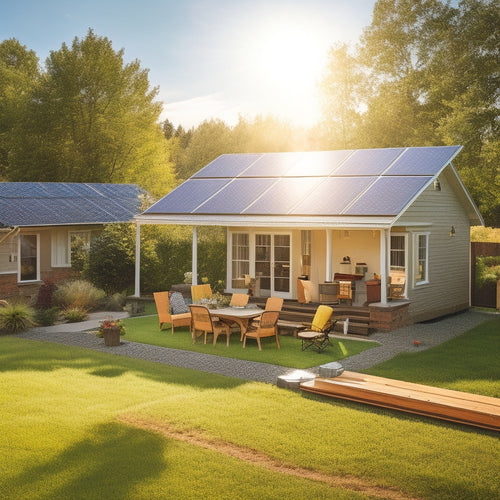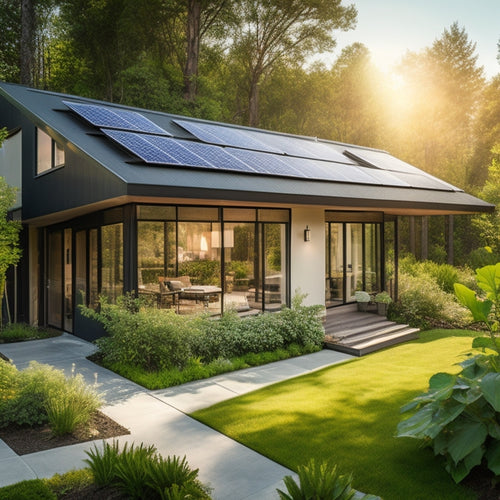
A Step-by-Step Guide to Calculating Residential Solar Installation Costs
Share
To accurately calculate residential solar installation costs, you'll need to assess your energy needs by reviewing utility bills and identifying peak usage periods. Next, evaluate your roof's size, condition, and orientation to determine its capacity for solar panels. Then, select the right solar panels by balancing efficiency, durability, and cost, considering factors like warranty and environmental credentials. Labor costs will also vary depending on installation complexity, permits, and inspections. Don't forget to investigate federal and state incentives, such as tax credits and rebates, that can greatly reduce your overall costs. By breaking down these factors, you'll get a clearer image of your total investment.
Key Takeaways
- Determine average daily energy usage in kWh by reviewing past utility bills to accurately estimate solar installation costs.
- Assess roof size, orientation, and condition to ensure optimal solar panel capacity and installation feasibility.
- Balance efficiency, durability, and cost when selecting solar panels, considering factors like warranty and environmental credentials.
- Break down installation labor costs into components like roof preparation, electrical installation, and system testing to estimate total costs.
- Research and factor in federal, state, and local incentives, such as the Solar Investment Tax Credit, to maximize savings on solar installations.
Understanding Your Energy Needs
Determine your energy usage patterns to get an accurate estimate of the residential solar installation costs. This involves analyzing your past energy consumption to identify your energy needs.
Review your utility bills to determine your average daily energy usage in kilowatt-hours (kWh). This will help you understand your energy consumption patterns, including peak usage periods and seasonal variations.
Consider your energy usage during different times of the day, such as morning and evening peak hours, and adjust for seasonal changes. This information will help you determine the required solar panel capacity to meet your energy needs.
Knowing your energy consumption patterns will also enable you to optimize your solar panel system's design for maximum solar efficiency.
Accurately evaluating your energy needs is vital to designing a solar panel system that meets your requirements. By understanding your energy consumption patterns, you can guarantee that your solar panel system is correctly sized to provide the necessary power and reduce your reliance on the grid.
This, in turn, will help you maximize your energy savings and achieve your desired level of energy independence.
Assessing Roof Size and Condition
Now that you've got a clear image of your energy needs, it's time to examine the other essential factor in residential solar installation costs: your roof. Your roof's size and condition play a significant role in determining the number of solar panels you can install and their overall efficiency.
To assess your roof's size, you'll need to calculate its square footage. This will help you determine how many solar panels can fit on your roof. Additionally, you'll need to take into account your roof's orientation, as south-facing roofs receive the most sunlight and are ideal for solar installations. East- and west-facing roofs can also work well, but north-facing roofs are generally not suitable.
A shading analysis is also vital to identify any obstacles that might block sunlight from reaching your solar panels. This includes trees, buildings, and other structures that could cast shadows on your roof.
Choosing the Right Solar Panels
Choosing the Right Solar Panels
Three key factors influence your choice of solar panels: efficiency, durability, and cost. You'll want to balance these factors to guarantee you're getting the best value for your money.
Panel efficiency, measured in watts per square foot, affects how much power your system produces. Higher-efficiency panels may cost more, but they can be more compact and produce more energy per hour of sunlight.
Durability is critical, as solar panels are a long-term investment. Look for panels with a 25-year warranty or more, and contemplate the manufacturer's reputation for producing durable products.
You'll also need to evaluate the type of solar panel: monocrystalline, polycrystalline, or thin-film. Each type has its pros and cons, including differences in efficiency, cost, and environmental impact.
Research installation brands and compare their costs, warranty options, and environmental credentials. A thorough cost comparison will help you make an informed decision.
Calculating Installation Labor Costs
With your solar panel selection in place, it's time to turn your attention to the labor costs associated with installation. Labor costs can vary greatly depending on the complexity of the installation, local labor market trends, and the installation techniques used.
To give you a better idea of what to expect, here's a breakdown of typical labor costs for different aspects of the installation process:
| Labor Component | Cost Range |
|---|---|
| Roof preparation and mounting | $1,500 - $3,000 |
| Electrical installation | $2,000 - $4,000 |
| Inverter installation | $1,000 - $2,000 |
| System testing and commissioning | $500 - $1,000 |
| Permits and inspections | $500 - $1,000 |
Keep in mind that these are rough estimates and can vary depending on your location, the size of your system, and the installer's level of skill. Be sure to get quotes from multiple installers to get a more accurate estimate of the labor costs for your specific project.
Incentives and Rebate Opportunities
In addition to federal and state tax credits, various incentives and rebate opportunities can greatly reduce the upfront cost of your residential solar installation.
You'll want to investigate these options to maximize your savings.
At the federal level, you're eligible for the Solar Investment Tax Credit (ITC), which allows you to claim a credit of 26% of the total installation cost.
This incentive can greatly reduce your tax liability, making your solar installation more affordable.
Additionally, many states offer rebates and incentives for residential solar installations.
These state-specific programs can provide cash rebates, tax credits, or property tax exemptions, further reducing the upfront cost of your system.
For example, California's Single-Family Affordable Solar Housing (SASH) program offers a rebate of up to $3 per watt for low-income households.
Be sure to research the federal incentives and state rebates available in your area to take advantage of these cost-saving opportunities.
Frequently Asked Questions
Can I Install Solar Panels on a Metal or Clay Tile Roof?
You'll need to assess installation considerations for your metal or clay tile roof, as certain roof types require specialized mounting systems or additional structural support to guarantee a secure and efficient solar panel installation.
Will Solar Panels Increase My Property's Value?
You'll likely see an increase in your property's value after installing solar panels, as it'll enhance your property assessment and provide a solid investment return, making your home more attractive to potential buyers if you decide to sell in the future.
Are Solar Panels Resistant to Hail and Extreme Weather?
You're probably wondering if solar panels can withstand the fury of Mother Nature - and the answer is yes! Solar panels are designed to resist hail damage and boast impressive weather durability, ensuring your power stays on even in extreme conditions.
Can I Sell Excess Energy Back to the Grid?
You can sell excess energy back to the grid through net metering options, where utilities measure your excess production and provide credits, or energy buyback programs, which purchase your surplus energy at a fixed rate, offsetting your utility bills.
Do Solar Panels Require Regular Maintenance?
You'll be relieved to know that solar panels are a low-maintenance sweetheart, requiring only routine inspections to guarantee peak performance, with a typical solar panel lifespan of 25-30 years, giving you decades of worry-free energy harvesting.
Conclusion
Now that you've crunched the numbers, you're one step closer to utilizing the power of the sun. As you envision your roof converted into a clean energy hub, remember that every dollar invested today is a savings tomorrow. Will you be watching your meter spin backwards, knowing you're generating more energy than you consume? With these calculations, you've got the tools to make that vision a reality.
Related Posts
-

Steps to Prepare for Solar Installation
To prepare for solar installation, start by evaluating your current energy consumption and future needs to determine ...
-

Integrating Solar Panels Into Home Design
Integrating solar panels into your home design greatly enhances energy efficiency and lowers utility bills while addi...
-

Energy-Efficient Home Upgrades for Cost Reduction
To reduce costs with energy-efficient home upgrades, focus on essential improvements like smart thermostats, energy-e...


